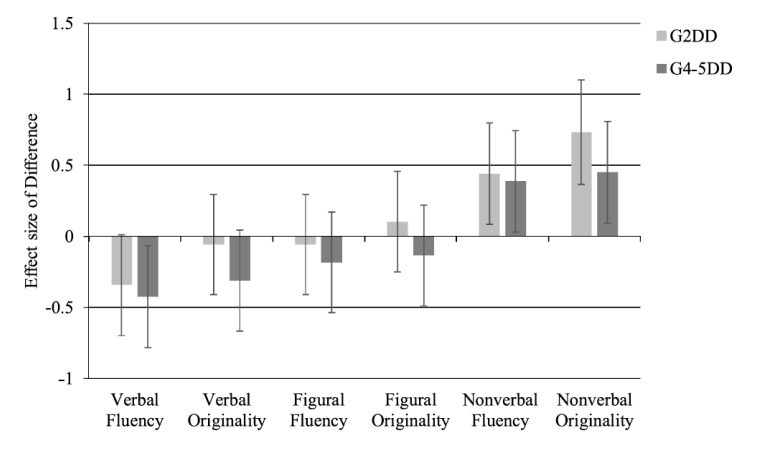“Individuals with dyslexia significantly outperformed controls in creativity scores in adult samples…”
– Majeed et al., 2021
In the past year, there have been two more studies to add to the creativity research literature on dyslexia. The first, a meta-analysis of 14 studies found clear patterns of stronger creativity among dyslexic adult subjects compared to non-dyslexics, but non-significant differences among children or adolescents.
The studies included a variety of creativity tasks and measures. Unfortunately, that paper offers little speculation about why that difference might exist, but with recent theories about the role of executive function and attention systems in creativity, it may be that the stronger performances on creativity tasks are only seen on a group basis after executive function abilities have matured.
In at least one European study of dyslexic children and adolescents on the drawing tasks of the Torrance Test of Creativity, dyslexics outperformed their non-dyslexic peers in the areas of originality and elaboration.
Interestingly, a study done in Hong Kong showed dyslexic 2nd and 4th graders showing strengths in nonverbal fluency and originality, though weaker performances verbally. Furthermore, these strengths were present without corresponding higher nonverbal IQ scores, suggesting that conventional IQ testing may miss these clusters of strengths.
From the paper: “Our results demonstrated that regardless of grade, Chinese children with DD (developmental dyslexia) exhibited higher nonverbal creativity and comparable figural creativity in relation to their TD (typically-developing) peers….despite their significantly weaker nonverbal IQ, Chinese children with DD still exhibited higher fluency and originality of nonverbal creativity than their TD peers, regardless of grade level or age.

Extending these previous studies (e.g., Cancer et al., 2016; Tafti et al., 2009), which reported enhanced nonverbal creativity strengths in children with DD, our study comprehensively assessed originality and fluency of creativity across verbal, figural and nonverbal modalities in both younger and older children with and without DD, and demonstrated for the first time that, despite their significantly weaker nonverbal IQ, Chinese children with DD still exhibited higher fluency and originality of nonverbal creativity than their TD peers, regardless of grade level or age.
Given that fluency and originality are key elements of outside-the box imagination and divergent thinking essential for achieving innovation (Kim, 2006), our results indicate that relative to their TD peers, children with DD were quicker to imagine diverse possibilities and generate broader and more unique visual responses. Also, since the responses were picture drawings that rely heavily on visual-spatial processing (West, 2008), the nonverbal creativity strength found in children…”
This suggests that, instead of solely emphasizing the “deficits” of children with DD, teachers, parents, and educational programs and curriculums should also underscore their potential for nonverbal creativity strengths and develop effective strength-based learning strategies that help them succeed and thrive in school and in the larger society.”















